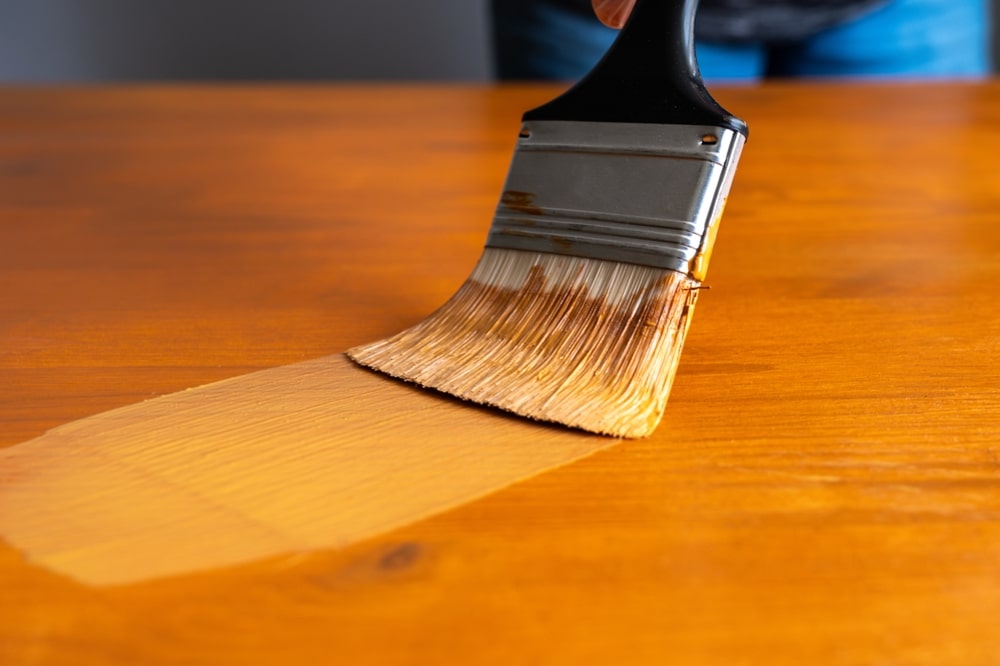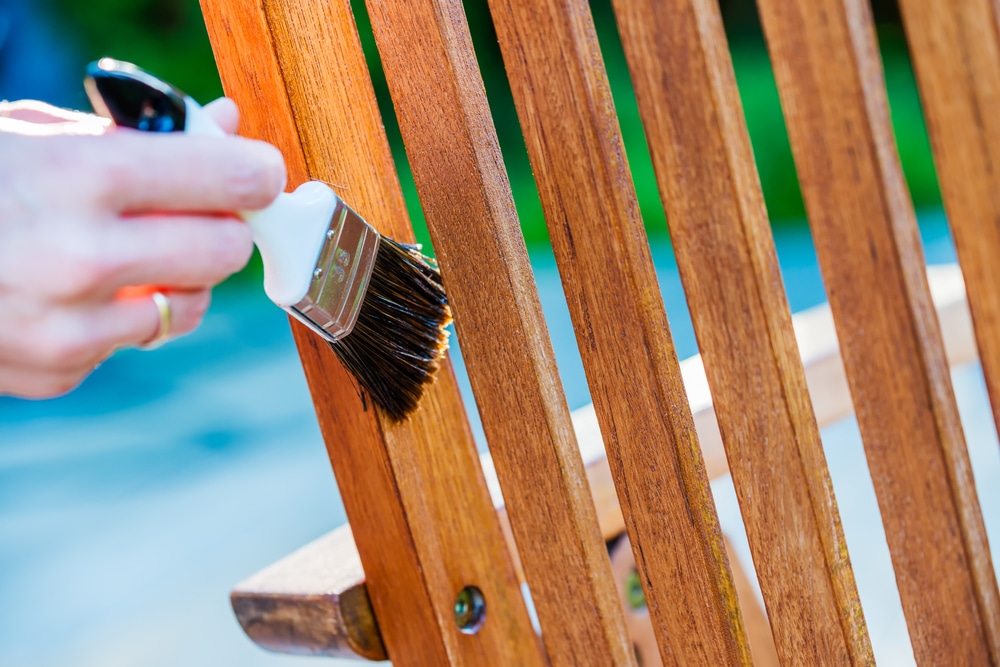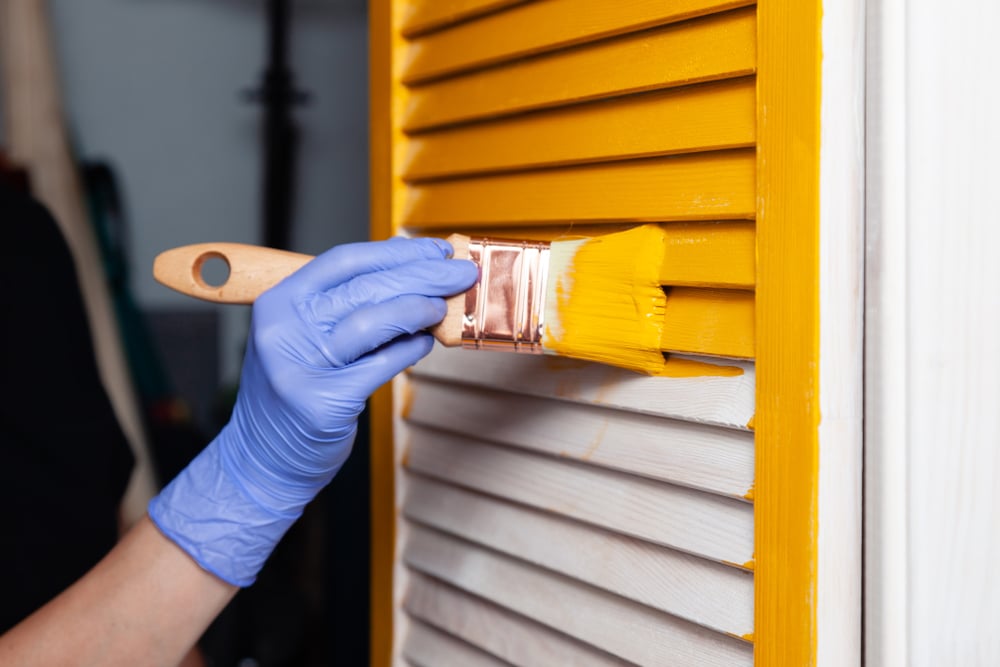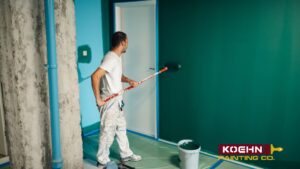Table of Contents
ToggleSo, you might be wondering, “Can I paint over stain without sanding?” Painting over stained wood without sanding is possible, thanks to modern preparation products such as bonding primers, liquid deglossers, and light abrasive scuff pads.
While heavy sanding to bare wood was once a necessity for adhesion, today, a thorough clean, chemical etch, or light scuff is often sufficient to create a suitable surface. Key products include shellac-based primers (e.g., Zinsser BIN) for sealing tannins and old varnish, oil-based primers (e.g., Kilz Original) for robust adhesion, and water-based bonding primers (e.g., Zinsser 1-2-3 or Benjamin Moore Stix) for lighter-duty applications.
Liquid deglossers chemically etch glossy finishes without dust, and non-woven abrasive pads or fine sandpaper can give satin and semi-gloss coatings just enough tooth. However, skipping prep entirely risks paint failure through peeling, bleeding, or flaking.
Whether sanding can be omitted depends on the wood’s finish, condition, and intended use. Sanding may be optional when the surface is lightly stained, unsealed, in good condition, and will receive a high-quality bonding primer; a liquid deglosser alone may suffice for low-impact items like trim or furniture.
But sanding is non-negotiable for glossy polyurethane or lacquer finishes, damaged or uneven surfaces, high-traffic areas, or any project where maximum durability is required. Proper preparation always includes cleaning, deglossing or scuffing, and priming, followed by two thin, well-cured coats of paint for best results.
Basically, the essential steps to never skip are:
- Clean & Degloss: Use a degreasing cleaner or liquid deglosser to remove oils and dull the surface.
- Prime: Apply a shellac-, oil-, or bonding primer based on stain bleed risk and traffic levels.
- Caulk & Wipe: Fill gaps or holes, then remove dust with a tack cloth.
- Paint: Use two thin coats of quality paint (latex or acrylic enamel), allowing full drying between layers.
Let’s dive deeper into this topic.
Can You Paint Over Stained Wood Without Sanding? Yes, But…

If you’ve thought: Can you paint over stained wood without sanding?, The quick answer is yes. Yes, you can, but here’s the thing: you must prep it right. While modern adhesion primers and deglossers can eliminate the need for aggressive, wall-to-bare sanding, you should still perform at least a light scuff (or chemical etch) on any sealed or glossy surface to ensure lasting paint adhesion. Today, bonding primers, deglossers, and even light scuff pads let you skip heavy sanding, but not all prep steps.
Today’s tools make it easier to paint over stain without having to worry about sanding, for example:
- Shellac-based primers (e.g. Zinsser BIN) excel at sealing tannins, dyes, and old varnish.
- Oil-based primers (e.g. Kilz Original) are also proven adhesion champions.
- Water-based bonding primers (e.g. Zinsser 1-2-3, Benjamin Moore Stix) work on light-traffic, non-bleeding surfaces—but always test first if tannin bleed or sealer residue is a concern.
- Liquid deglossers (also known as liquid sandpaper) chemically etch the sheen on polyurethane, lacquer, or gloss finishes—without the need for dust or elbow grease—and you can paint over them directly.
- Abrasive (scuff) pads can provide light mechanical tooth on satin or semi-gloss finishes—but choose the right grade (green or gray non-woven pads, or 120–150 grit sandpaper) to avoid under-abrading, especially slick factory finishes.
So, can I paint over stain without sanding? You can clearly see that you can, but while you can skip sand, you should never skip the preparation. Skipping sanding doesn’t mean skipping prep. Your surface still needs to be clean, etch-ready, and primed. If not, paint will flake off, bleed, or peel fast.
Paint can’t bond to slippery surfaces. It needs a clean, etched, or primed layer to grip onto. Whether you sand, degloss, or scuff, you must ensure that adhesion, or you’re wasting time and paint.
When You Can Skip Sanding (And When You Shouldn’t)
So, when can you actually get away with skipping sanding—and when is it just asking for trouble? Let’s break it down.
Sanding can be optional when:
- You’re working with lightly stained wood with no glossy sealant on top.
- The surface is in good condition and you’re using a high-quality bonding primer like Kilz or BIN.
- You’ve applied a liquid deglosser and let it cure properly.
- The project is low-impact, like trim, molding, or lightly used furniture.
Sanding is definitely non-negotiable when:
- The stain is sealed with a high-gloss varnish or polyurethane; these coatings repel paint without requiring aggressive preparation.
- The surface is chipping, flaking, or uneven; you’ll need to remove loose material to get a smooth finish.
- You’re painting high-traffic surfaces (like stairs, floors, or cabinet doors) that require maximum durability.
- You skipped cleaning first; dirt, grease, and old wax will compromise adhesion, regardless of how good your primer is.
So, can you paint over stained wood without sanding? Yes—but only with the right materials, surface conditions, and a solid understanding of how adhesion works, something truly important.
Sanding might not always be required, but prepping always is. And if skipping sanding sounds like a tempting shortcut, just remember: shortcuts only work if you know when and how to take them.
Contact us here if you would like to find the best painting contractor for your residential or commercial painting needs.
How to Paint Over Stained Wood: All the Steps

If you’re wondering “Can I paint over stain without sanding?” You’re not alone. Many homeowners and DIYers face the same dilemma, how to paint over stained wood without the hassle (and dust) of sanding. The good news is that you can paint over stained wood without sanding if you do it right.
Thanks to modern bonding primers, liquid deglossers, and a few insider tricks, the sanding step—once considered sacred—isn’t always necessary. But as we’ve mentioned above, skipping sanding doesn’t mean skipping prep. The key to success lies in knowing how to paint over stained wood the proper way.
Tools and Materials You’ll Need
- Degreasing Cleaner (removes oils, waxes, and grime)
- Liquid Deglosser (also called “liquid sandpaper,” for chemically etching gloss finishes)
- Bonding primer (Valspar, Kilz Adhesion, Zinsser BIN, or Benjamin Moore Stix)
- Tack cloth or microfiber cloth (for dust removal)
- Foam roller or quality brush (for smooth application)
- Caulk (optional, for trim and cabinetry)
Safety First: Many deglossers and shellac primers emit strong solvents. Always work in a well-ventilated area, wear chemical-resistant gloves, eye protection, and, if recommended, an organic-vapor respirator per the product’s Safety Data Sheet.
Step-by-Step: How to Paint Over Stain Without Sanding
How do you paint over stained wood without sanding? With methods and techniques tested by both professionals and DIYers for furniture, cabinets, stair risers, and trim.
- Clean Thoroughly with a Deglosser: Start by scrubbing the surface with a chemical cleaner that combines degreasing and deglossing. This removes the build-up of oils and dulls the finish, creating a tacky surface that primer can stick to.
- Apply a Bonding Primer: Don’t skip this. Professionals emphasize, “You must de-gloss or your paint will all flake off.” Apply one coat of bonding primer, such as Kilz Adhesion or Valspar Bonding Primer. This acts as the bridge between your stain and paint, like “peanut butter between slices of bread”.
- Caulk and Patch (If Needed): Once primed, fill any holes or gaps. Use caulk on trim and cabinetry seams for a polished result.
- Wipe Again Before Painting: After caulking, use a tack cloth or microfiber cloth to remove dust and ensure a clean surface.
- Apply Two Thin Coats of Paint: Choose a durable latex or acrylic enamel paint. Apply two thin coats with a foam roller or brush, allowing proper drying time between coats. This will ensure a long-lasting finish, even without the need for sanding.
Still wondering, “What happens if you don’t sand before repainting?” If you skip cleaning or priming, paint may blister, peel, or fail to adhere. Adhesion failures are a main issue with poorly prepped, stained wood.
Common Issues When Painting Over Stain Without Sanding
While the step-by-step should act as a clear, thorough process to follow, there are still some common issues when painting over stain when you don’t sand, such as:
- Bleed-through: If your stain contains tannins or dyes, use a shellac-based primer like Zinsser BIN to prevent bleed-through.
- Peeling paint: This often results from dirty surfaces or skipping primer. Proper prep—especially deglossing—is key.
- Rough finish: Caused by trapped dust. Use tack cloths before painting.
- Chipping: High-traffic items like stairs and cabinet doors might still benefit from light scuffing to boost durability.
So, can you paint over stained wood? Absolutely. Can you paint over a stain without sanding? Indeed. Just don’t skip the prep. Knowing how to paint over stained wood correctly will save you time, stress, and expensive do-overs.
The secret isn’t brute-force sanding, but thoughtful and smart preparation. With the right products and a little patience, your project can go from outdated to stunning without ever plugging in a sander.
If you’re still wondering what happens if you don’t sand before repainting, just remember: it’s not about sanding; it’s about adhesion. And that starts with cleaning, deglossing, and priming.
Can I Paint Over Stain Without Sanding: FAQs

It’s pretty clear by now that the answer to many homeowners’ question: “Can I paint over stain without sanding”? Yes, but with the proper preparation. Still, that’s not the only one. Here’s a quick FAQ to address other top questions around:
How do you paint over stained wood without sanding?
Clean thoroughly, apply a liquid deglosser to dull the finish, then use a quality bonding primer before painting.
Can you paint directly over stains?
Yes, using a stain-blocking primer seals in the stain and prevents bleed-through, allowing paint to adhere properly.
Can I stain over stain without sanding?
Generally, no, but yes, it’s possible. New stain needs an absorbent, roughened surface, so sanding (or chemical prep) is necessary for even adhesion.
Do I need to sand before painting over the stain?
Only if the surface is glossy, damaged, or high-traffic. In most other cases, a two-step clean-and-degloss followed by a shellac or adhesion primer will suffice—but a quick scuff-sand never hurts your adhesion profile.
How to paint wood that has been stained?
Clean, degloss, prime with a bonding primer, paint, and optionally seal with a topcoat for durability.
What is the best primer to cover stained wood?
Shellac-based (Zinsser BIN) for tannin-rich or glossy finishes; oil-based (Kilz Original) for tried-and-true adhesion; water-based bonding (Stix, 1-2-3) for low-impact, clean surfaces.
What happens if you don’t sand before repainting?
Often, this leads to paint peeling, flaking, or bubbling due to poor adhesion. Sanding, deglossing, or priming can help avoid this issue.
Skipping sanding can save hours, and it’s totally viable when you clean, degloss, and prime correctly. Even pros skip sanding on the right surfaces with the right products. But if your stained wood is glossy, damaged, or tricky, proper prep is non-negotiable. And if it feels overwhelming, hiring Koehn Painting ensures peace of mind and a flawless finish from start to finish.
Discover the Koehn Painting difference – contact us today for a free estimate and step into a vibrant, freshly painted home!




